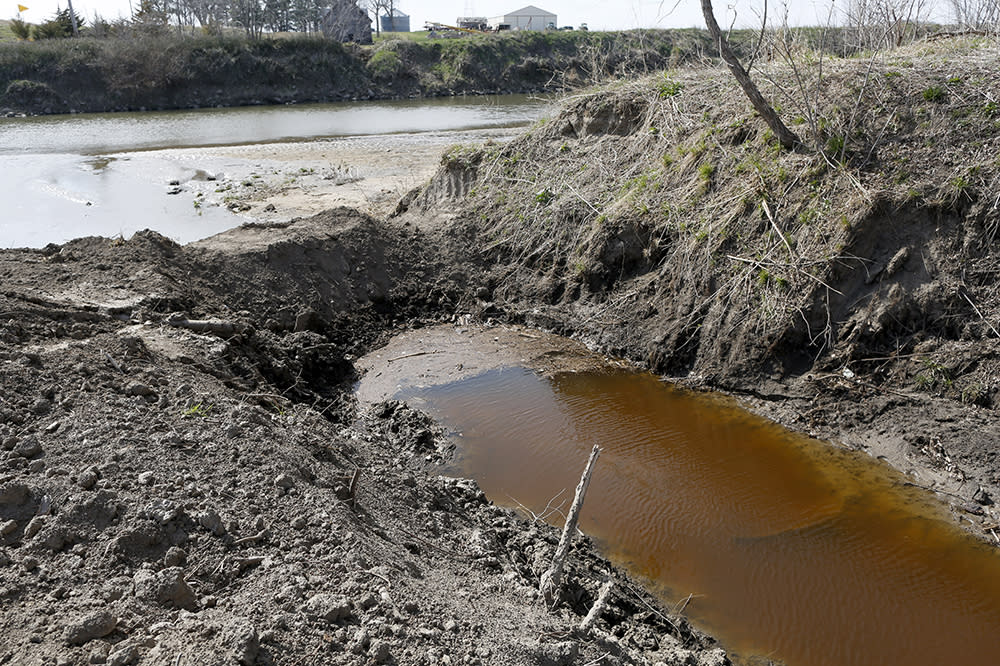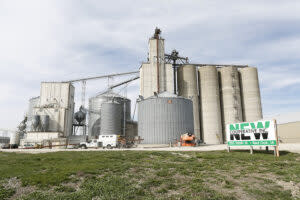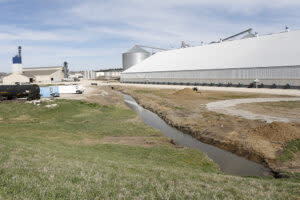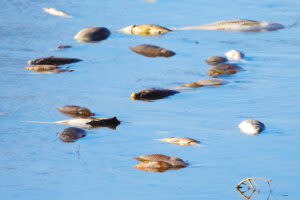Commission asks attorney general to litigate massive fertilizer spill

NEW Cooperative used soil to block a ditch that goes to the East Nishnabotna River to prevent further contamination from a March fertilizer spill. (Photo by Jared Strong/Iowa Capital Dispatch)
The state’s Environmental Protection Commission voted unanimously Wednesday to refer one of the largest fertilizer spills in the state’s history to the attorney general’s office for enforcement.
In doing so, the commission granted a referral request from the Iowa Department of Natural Resources, which said its administrative fine limit of $10,000 is insufficient for the March spill at NEW Cooperative in Red Oak. The incident contaminated the East Nishnabotna River and killed more than 750,000 fish.
The attorney general can seek a much higher penalty in court.
“A $10,000 penalty is simply not commensurate with the harm caused by this case,” said Bradley Adams, a DNR attorney.
Representatives of the cooperative, which is based in Fort Dodge, did not challenge the referral and said it worked quickly to mitigate the spill that was caused by the mistake of one of its employees.
“Frankly, NEW Cooperative doesn’t see a reason to invite a combativeness in front of this commission,” said Brittany Barrientos, an attorney for the co-op. “We have otherwise proceeded cooperatively, and so with that spirit, that’s how we plan to proceed today.”
Here’s what happened, according to Barrientos: Co-op employees had worked for days to prepare a 500,000-gallon tank of liquid nitrogen fertilizer for distribution. The fertilizer — a urea ammonium nitrate solution that is commonly known as UAN-32 — had partially crystalized over the winter and clogged a line that is used to dispense it.
On Friday, March 8, the employees inadvertently left a valve to the line open. There was no fertilizer flowing from it at the time, but at some point over the weekend — when no one was present — the warm weather apparently cleared the blockage. About 265,000 gallons of the fertilizer flowed over the ground and through a stormwater drain into a ditch that goes to the river.
GET THE MORNING HEADLINES DELIVERED TO YOUR INBOX
The spill was discovered early Monday, March 11, when co-op employees began their work week. They constructed a series of dams to stop further contamination of the river, but it was too late to prevent the annihilation of fish, frogs, mussels and snakes downstream in the river.
“A 50-mile stretch of the river became uninhabitable for aquatic life,” Adams said. He added: “The fish literally choked to death in the water.”
The devastation continued another 10 miles into Missouri until the Nishnabotna reached the Missouri River, where the fertilizer diluted in higher water flows.
An assistant attorney general indicated the office would pursue the case but did not comment further about it. It’s unclear how much money the attorney general’s office will seek from NEW Cooperative. The fines are typically negotiated as part of a settlement agreement.
The largest fish kill event on record resulted in a $150,000 settlement, according to DNR records. In that case, an unspecified amount of liquid nitrogen fertilizer discharged from Midwest Farmers Cooperative in Sheldon into the Floyd River in January 2002 and killed more than 1 million fish.
The value of those fish, which is used to determine restitution to the state, was about $120,000.
The fish killed by the NEW Cooperative spill have been valued at about $226,000. Adams said money from a settlement with the co-op will be used to rehabilitate the East Nishnabotna and Nishnabotna rivers.
Missouri officials are mulling penalties as well and recently asked residents to watch for dead fish this summer that might result from residual fertilizer contamination in river sediment.
“It’s possible the fertilizer could mobilize once the water warms up this summer, resulting in another fish kill,” said Matt Combes, a Missouri Department of Conservation supervisor.
An estimated 40,000 fish died in Missouri as a result of the spill.
The co-op has excavated a large amount of contaminated soil from the creek that goes to the East Nishnabotna to prevent further pollution, said Dan Dix, its general manager.
“Our company has always operated under the philosophy of striving to do the right thing (for the) customer, employee and the environment,” Dix said. He added: “Unfortunately, it was simply due to a mistake, an accident caused by a long-term employee. We take this matter very seriously.”
NEW Cooperative is the largest farmers’ co-op in Iowa and has about 12,000 member owners. Dix said it acquired the Red Oak site last year as part of a merger with United Farmers’ Cooperative.
The post Commission asks attorney general to litigate massive fertilizer spill appeared first on Iowa Capital Dispatch.




